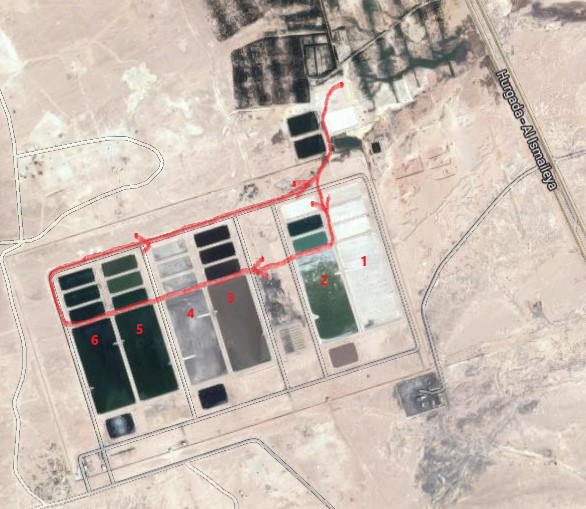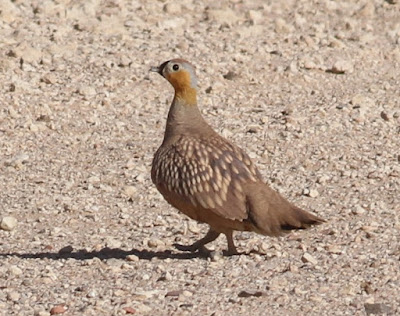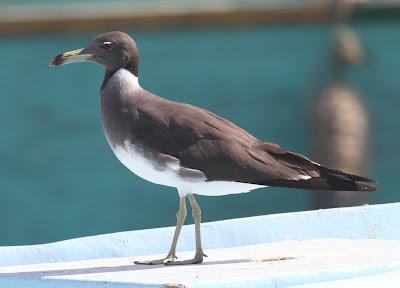Crocodile Island was easy to get to by taxi (60 Egyptian Pounds). The island has a single massive hotel, Jolie Ville, and they treat the island as their own possession. I had a few issues with security guards the second time, but once I presented myself at Reception the hotel staff were fairly accommodating and let me wander around.
The most noticeable birds in almost every area are the various different species of heron.
Squacco Heron are particularly numerous, as are
Purple Heron which outnumbers the
Grey Herons by a large factor. Both
Cattle Egrets and
Little Egrets are also common, a decent-sized heronry consisting of nests of both species is in the northern part of the hotel.
Pied Kingfishers are also here in quite large numbers.
The northern part of the island is dominated by the hotel, and its manicured grounds. The lawns are good for
Hoopoe, and I found several groups of
Eastern Olivacous Warblers and
Lesser Whitethroat in the bushes and trees. The football field in the northeast is also a good spot to get close views of
Spur-winged Plovers.
The southern tip of the island is fenced off completely. Access is possible, but would involve clambering through a large fence. Beyond the fence is a large area of very short grass and not much else. There were plenty of Wagtails and Pipits on the grass, as well as
Northern Wheatears and Hoopoe.
The best birding areas are the east and west flanks of the island. In the east are a number of small farms (mainly onions and similar crops) with scattered low bushes, areas of short grass, and reedbeds. In the west the farms are larger, and are mainly wheat, there are similar areas of short grass and reedbeds.
The reedbeds in the east were easier to access, and were very productive.
Clamorous Reed Warblers were very noticeable, but there were also
Eurasian Reed Warblers, Sedge Warblers and a
Red-spotted Bluethroat. Hirundines here included
Sand Martin, House Martin and two different races of
Barn Swallow (Red-bellied and White-bellied forms). The short grass was filled with various different races of
Yellow Wagtail (see later post), and loads of
Red-throated Pipits. The farms in this area were in various states of harvesting, and the fields with bare ground were good for larks. I had both
Crested Lark and
Thekla Lark, my first ever sighting, totally unexpected.
Another unexpected bird in the east was
Masked Shrike, of which I saw at least 4 different birds. Very flighty, but very nice.
The farms in the west were less interesting, lots of
Fan-tailed Cisticola and
Graceful Warbler, as well as both
Little Green Bee-eater and
Blue-cheeked Bee-eater but not much else. The short grass areas had similar groups of
Yellow Wagtails and
Red-throated Pipits, as well as a group of 3
Painted Snipe.
The reedbeds in the west were extensive but harder to get close to than the east, though I did get great views of an
African Swamphen here.
I had a chance encounter with a very nice local chap called Mahmoud who took me out in his boat to get a closer look at the shallow areas south of Crocodile Island, which was great. The headline item here was a group of 8
Ferruginous Ducks, as well as both
Whiskered Terns and
White-winged Black Tern, Western Marsh Harrier, and another group of 4
African Swamphen.
One of at least 4 different
Masked Shrikes in the eastern fields
Red-spotted Bluethroat showing very well.
Sedge Warbler
Eurasian Reed Warbler
Clamorous Reed Warbler. Common, and very noisy...
Eastern Olivaceous Warbler
Lesser Whitethroat
Ferruginous Duck. Very flighty so no decent photographs unfortunately
Crested Lark. Note the longer crest, buffier breast spots, and curved upper and lower mandible...
...in contrast with this
Thekla Lark. Shorter crest, darker less diffuse breast spots, and straight lower mandible. When seen side by side they are quite different birds
Male
Painted Snipe.
African Swamphen.
Nile Valley Sunbird. Another endemic down!
This magnificent summer-plumaged
White-winged Black Tern was the last bird I saw as I crossed the bridge on my second visit. A wonderful send-off!

















































